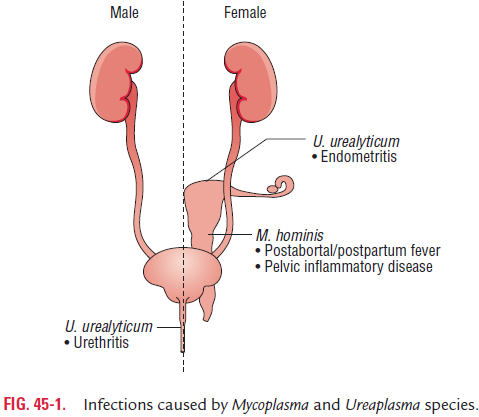Chapter: Microbiology and Immunology: Bacteriology: Mycoplasma and Ureaplasma
Clinical Syndromes - Mycoplasma pneumonia
Clinical Syndromes
M. pneumoniae primarily causes respiratory infections inhumans.
◗ Respiratory infections
Majority of the respiratory infections are mild and self-limiting. M. pneumoniae causes (a) upper respiratory tract infections,(b) lower respiratory tract infections, and (c) primary atypical pneumonia.
Upper respiratory tract infections: M. pneumoniaetypicallycauses mild upper respiratory tract infections. The condition is characterized by low-grade fever, malaise, and headache. Nonproductive cough is a typical manifestation, which appears 2–3 weeks after exposure. The cough is initially nonproductive but may later produce small to moderated quantities of spu-tum, which may become mucopurulent and even blood tinged in more severe cases.
Lower respiratory tract infections: These include tra-cheobronchitis and bronchopneumonia. The condition is characterized by primary infection of bronchi with infil-tration of bronchial epithelial cells by lymphocytes and plasma cells.
Primary atypical pneumonia: The condition is also knownas walking pneumonia. Incubation period varies from 2 to3 weeks. Patients suffering from atypical pneumonia usually do not appear ill. Hence, the illness is often referred to as walking pneumonia. The pharynx is affected, becomes edematous but without any cervical adenopathy. The condition is associated with presence of patchy bronchopneumonia seen on the chest X ray. Disparity between physical findings and radiological evidence of chest is the hallmark of infection. The infection is usually self-limiting. In 5–20% of patients, pleural effusion may occur.
◗ Extrapulmonary infections
Extrapulmonary manifestations are not rare. Cardiac abnormal-ities, such as myocarditis and pericarditis are the most frequently reported extrapulmonary manifestations. Other manifestations include neurological abnormalities, otitis media, and erythema multiforme (Stevens–Johnson syndrome). M. pneumoniae infec-tions tend to cause much more severe disease in:
· children suffering from immunosuppressive disease;
· individuals with sickle cell anemia, functional asplenia and
· children with Down syndrome.
Subclinical infection may occur in 20% of adults (Fig. 45-1).

Related Topics